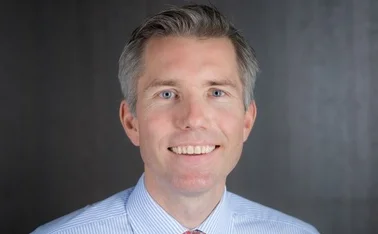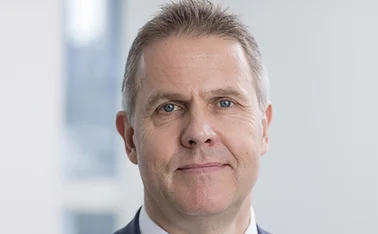
Up, up and away!
Scott Carmilani, chief executive of Allied World Assurance Company (AWAC), has been so busy jetting around doing business his feet have rarely touched the ground. Mairi Mallon managed to catch up with him to get a work-in-progress report
For three weeks following the initial public offering (IPO) of Allied World Assurance Company (AWAC), Scott Carmilani's feet did not touch the ground.
The Bermuda company, which was set up in 2001 after the capital crunch following the 9/11 terrorist attacks, hired a private jet to make sure that their chief executive officer and his team got around the globe in less than 80 days.
During the three-week stint, he and his team visited over 180 investors, doing five European countries in three days, in one day getting in six meetings out of a tour of Minneapolis, Houston and Denver.
"There was a great deal of preparation in the months from the time you file until you go out on the road, but three weeks is a very gruelling process," Mr Carmilani said of the effort.
In July, AWAC raised nearly $300m through an initial public offering of its shares, after pricing its offering of $8.8m common shares at $34 per share.
Mr Carmilani still sounds as if he is recovering from this epic fund-raiser, which not only saw the company release its IPO, but also held a $500m senior-notes offering. He says that it has been a great achievement for him personally, as it was always his ambition to take the company public from day one.
AWAC was set up by heavyweights American International Group (AIG), Chubb Corporation and GS Capital partners in 2000, and capitallised by an investment fund managed by Goldman Sachs in late 2001. It has since become one of the biggest and most successful companies in its class.
In its first year, it went from no income to $923m and $1.57bn in 2003. In August, it made a 47.5% jump in net income to $200.5m for the first six months of 2006.
'Formidable' skills
Much of this meteoric success has been attributed to Mr Carmilani's formidable management skills.
A fresh-faced Mr Carmilani first arrived in Bermuda to the chaos of a new company being set up in a big hurry. Industry veteran Michael Morrison had been lured out of retirement to take the helm, and Mr Carmilani was lead investor and AIG's golden boy. He was sent in under the title of executive vice-president to build up the company, set up the right structures and policies, and essentially make sure it made a return for AIG's big bucks.
An AIG man through and through, Mr Carmilani joined the company in 1987, and held a succession of underwriting and management positions. He was a favourite of Maurice 'Hank' Greenberg. Before being sent to Bermuda, he was president of the Mergers & Acquisition Insurance Division of AIG subsidiaries, and was responsible for the management, marketing and underwriting of transactional insurance products for clients engaged in mergers, acquisitions or divestitures.
Shortly after arriving in Bermuda, Mr Carmilani realised the full potential of AWAC, and he was quickly groomed by Mr Morrison to take over the helm, which he did in 2003. He was only 39 at the time.
"I originally came to Bermuda as an employee of one of the investor companies, AIG, and I came down to help with the structure and the set-up," he told Reinsurance. "Quickly, I realised I had a potential business opportunity with the market dislocation. It was a great business opportunity and a great career opportunity to come in and help out.
"It was always the design that I would help with the architecture and the build-up of the company, and I would eventually have the opportunity to take it over.
"So although Mike (Morrison) stepped down and I had to fill his shoes, it was sort of a long period of transition, but once it had happened it was rather easy to take the reins.
"The only thing was that he was no longer here, so I didn't have that elder statesman to get advice from or to be able to listen to his wisdom from time to time and use it as a check and balance on a regular basis."
Mr Morrison still remains on the board of directors, and often visits Mr Carmilani as a friend when he holidays in Bermuda.
"When I got here, it was Mike and a handful of folks on the underwriting side, and that is just about it. And I helped them to build all the departments, bringing in an IT function, an accounting function, a legal function and an HR function. I helped them build up and hire the rest of the underwriting staff for Europe and the US, as well as help the folks that were already here set up their departments and assist them in going about obtaining business and structuring the files, the underwriting procedures and the policies' guidelines, and that sort of thing."
Consolidation and preparation
After this was a time of consolidation and building a worldwide network, while the IPO preparations were never far from his mind.
"Preparing for an IPO is not an easy task, I can tell you first hand," he said. "It is a lot of hard work and takes a lot of perseverance. Literally, your feet barely touch the ground for two and a half to three weeks. As we did it near the US 4th of July holiday and the World Cup soccer matches, it got extended over three weeks to be able to get to everybody, and see all the potential new investors.
"We went from the (US) west coast to the mid-west to the southwest, the southeast up the coast and back to Bermuda. It was a long, tiring process. The underwriters lease a jet, because your schedule is so tight you need one in order to accomplish the multiple states and multiple meetings in the same day. You really have to be on a schedule where there is a plane leaving for somewhere else right away. You could never accomplish that in today's day and age, based on the security measures and checking in baggage, and all the things that go on in airport security these days."
Mr Carmilani said that reporting they are a public company now is not so different as when they had released their detailed results to their 200 shareholders in a formalised manner. What did knock him off kilter was the daunting prospect of having to do a conference call for the first time after they released their first set of results as a listed company.
"It's a little uneasy the first time," he said. "There are about 35 different analysts and investors on the call. You never know what kind of question you are going to get, or if any of them are angst-ridden about your results.
"But we had very good results, and we were one of the last of the class of 2001 that had the conference call in the season, so most of the questions were fairly easy. I think they took it easy on us for the first time as they were easy to answer, and the combination of the questions and the fact that we had good results made it a delightful experience. I think they are always easy as long as things are going well."
Volatility response
Mr Carmilani said that the hurricanes of last year did not knock them off course, and said they were paying the claims that had affected their cash flow. However, he said the initial estimates that came out in December and January had held.
"This has been a real positive for the company. We had a very good estimation of our expected losses, and we haven't had to add to our reserves or take any additional charges in 2006. That proved to be a very stable presentation, and gave confidence to the analysts while we were in the road show. They felt very comfortable with the fact that we had a firm handle on our expected losses."
He admitted that their model "didn't hold up at all" and their result, as it was across the industry, was very different from that of the expected model. "But it was very much in line with how we manage our aggregate," he said. "We were able to determine what our outcome was - absent the model - even though it ended up being 30-40% higher than what the model said."
He said that the severe windstorms of last year had affected their risk appetite and changed how they manage their ultimate aggregate exposures."We even use more conservative methodology than we did," he said. "While we use the models to check off and report to rating agencies, we use a much more conservative approach in what our ultimate exposures are and what our expected probable maximum losses could be; a one-in-every-hundred-years event or the probability of a one-in-every-250-years event are dealt with in a much more conservative way than previous models had accounted for.
"We have also shifted the eggs around a bit - we have reduced the volatility (by about 30%). The amount of premium we write is actually higher (17% in the second quarter), but the amount of aggregate exposure or catastrophe-exposed business is a little less.
"We have shifted the mix a little bit and we have changed the volatility of that business, meaning we either changed the layer or changed the amount we provide in catastrophe-prone areas, and added more insurance to areas that were less catastrophe-affected and things of that nature, and we also geographically spread the business more."
Storm projections
Mr Carmilani thinks it is unlikely that there will be another storm this year with losses as big as Katrina for (re)insurance companies.
"I don't think you will see the same kind of impact as Katrina because although the storm may be as big, I don't think the companies will have as big a loss because most of them have taken a more conservative approach to their portfolios this year, and either bought different protections or wrote less business," he said.
"I think many of the carriers put more emphasis on their aggregate exposures than their volatility this year. A few took bigger bets in different areas, and if another storm hits on that exact spot, they may have a bigger loss than they did previously.
"I think the industry is better prepared than it was a year ago, but of course if we have that $100bn-plus event, then the whole industry would be affected ..."
He pointed out that the modelling companies said there is a potential for a $100bn-plus event, and that it could be in the northeast.
"If that were to happen, I believe that the industry would be in a capacity and capital crunch again, much like it was after 9/11 and around Katrina," he said. However, he thinks there would still be money out there interested in re-capitalising the market.
"I think they will be more sceptical and more conservative as to who they put their money with, and there might be consolidation as to how much capital is available," he said. "But there will always be opportunity for markets in distress, and smart capital markets will take advantage of that or provide that source of funds - they can see the potential for return."
Future plans
When asked if the company had a five- or 10-year plan, Mr Carmilani laughed and said: "We have only been in business for five years, so a five- or 10-year plan seems like a lifetime for us.
"But we are this year, for the first time, putting together a three-year outlook that we would use internally on how we were going to take the company forward. This is not something we would give as a forward-looking statement for investors, but would help us prepare for the future better.
"We have five years' of maturity now and have enough time under our belt, enough seasoned quality among the staff and the team, and you have to understand the future as much as you have the past, so you have to be prepared."
As a tribute to Mr Carmilani's work, AIG have not sold their investment, which is still at 19%. The company is about to move into one of the biggest offices ever to have been built in Bermuda, a 75,000-square-foot, new purpose-built office, set smack bang in the shadow of AIG's huge offices there.E
Only users who have a paid subscription or are part of a corporate subscription are able to print or copy content.
To access these options, along with all other subscription benefits, please contact info@postonline.co.uk or view our subscription options here: http://subscriptions.postonline.co.uk/subscribe
You are currently unable to print this content. Please contact info@postonline.co.uk to find out more.
You are currently unable to copy this content. Please contact info@postonline.co.uk to find out more.
Copyright Infopro Digital Limited. All rights reserved.
You may share this content using our article tools. Printing this content is for the sole use of the Authorised User (named subscriber), as outlined in our terms and conditions - https://www.infopro-insight.com/terms-conditions/insight-subscriptions/
If you would like to purchase additional rights please email info@postonline.co.uk
Copyright Infopro Digital Limited. All rights reserved.
You may share this content using our article tools. Copying this content is for the sole use of the Authorised User (named subscriber), as outlined in our terms and conditions - https://www.infopro-insight.com/terms-conditions/insight-subscriptions/
If you would like to purchase additional rights please email info@postonline.co.uk







